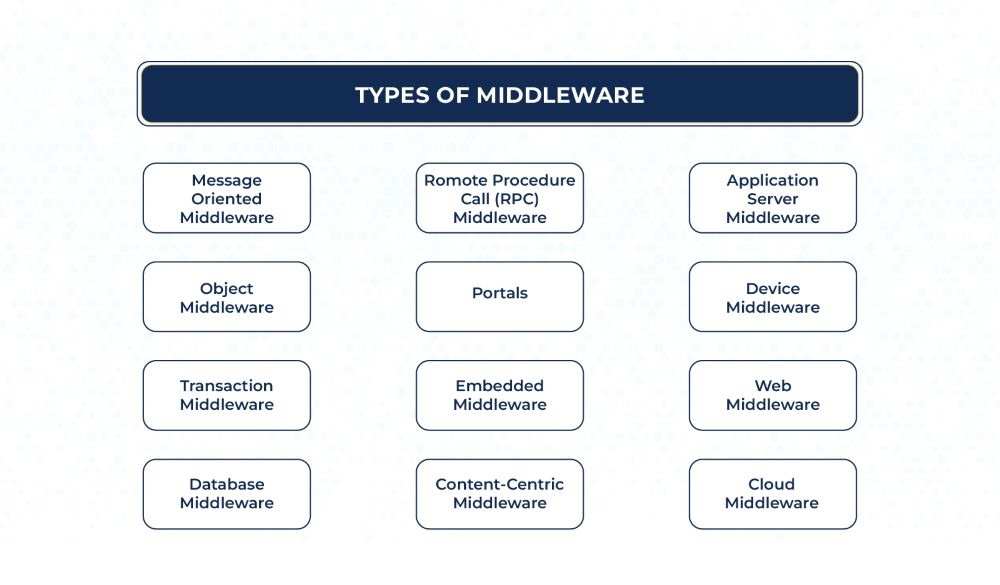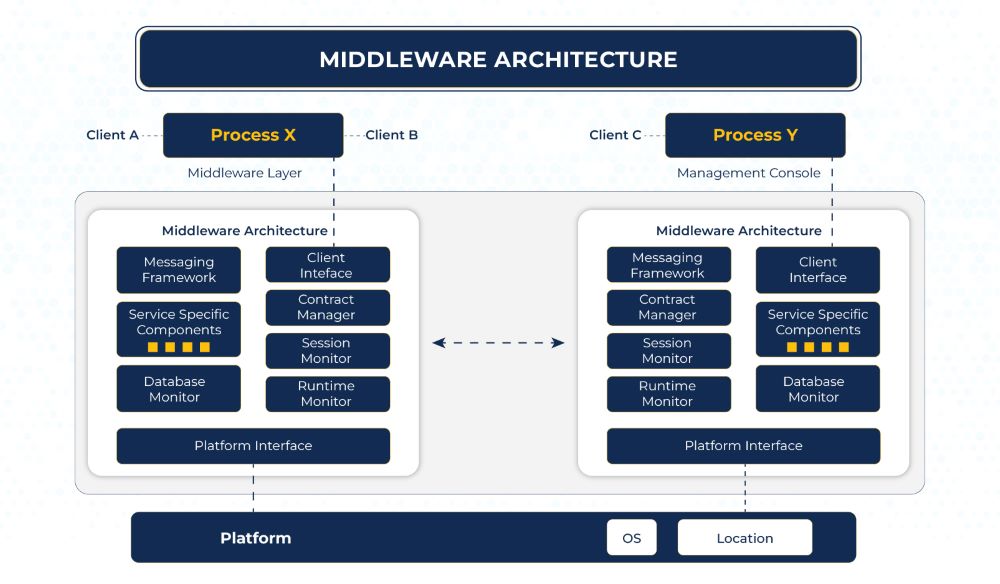What do you notice the most when you use software? Most people would say it’s user interface and performance. Those are indeed important elements of good software, but there is one crucial component that remains unnoticed.
Middleware software often operates behind the scenes. It facilitates the connection between different applications, systems, or services.
This article will explain what middleware software is, its types and purpose, its architecture, and best practices.
What is Middleware Software?
Middleware refers to software that enables interaction, connectivity, and communication between different applications or application components. It also allows for the transmission of information between different applications that were not originally designed to connect, thus giving new functionality. Think of middleware applications as translators between people who speak different languages.
There are two major categories of middleware software:
- Platform Middleware: Platform middleware provides the tools and runtime environment required for the development, deployment, and execution of software applications.
The goal of platform middleware is to facilitate the creation and delivery of software by simplifying the complexities of various hardware and software environments.
- Enterprise Application Integration (EAI) Middleware: EAI middleware focuses on helping businesses integrate various software application development in environments with diverse systems. It removes the need for custom-built interfaces for smooth communication and data exchange between disparate applications.
The term middleware refers to the software’s mediatory role between an application’s front and back end (specialized hardware device, database, or mainframe application). Middleware software optimizes the application development process by allowing diverse applications to connect. It thereby reduces the time to market. Moreover, it provides a standardized user experience.
Purpose of Middleware
Middleware applications began as a liaison between new programs and legacy systems. Developers initially used them to integrate new programs with earlier systems without rewriting the code.
Over time, middleware development gained popularity, and today, it is an important tool in data management and communication.
Below are the main functions of middleware software:
- Integration Support: Middleware allows different systems, applications, or services to communicate and exchange data.
- Data Transformation: One purpose of middleware is to convert data formats from one system to another for smooth communication between different platforms.
- Protocol Translation: Middleware benefits by translating between different network protocols.
- Scalability: It supports the addition of new systems or components without significant reconfiguration.
- Message Passing: Modern applications consist of many microservices that talk to each other. Middleware facilitates the reliable exchange of messages between these small software components.
Types of Middleware
There are many types of middleware, depending on the capabilities they offer. We have listed the common types below.

-
Message-Oriented Middleware
It enables applications to communicate with each other through messages across different network protocols and operating systems.
-
Database Middleware
Database middleware allows access to and interaction with various database gateways. It is the most common middleware.
-
Portals
Businesses use portals to enable interaction between the backend and client-facing systems.
-
Transactional Middleware
It functions as a means to ensure that electronic transactions are executed properly in a distributed network.
-
Enterprise Application Integration
It links data, processes, applications, and services regardless of their location (on-premises or cloud) and technology. Moreover, it allows for the free flow of data between applications without needing any major changes in the applications or database configurations.
-
RPC Middleware
Remote Procedure Call middleware allows a program to request a service from or trigger an action in another program residing in another computer. It is also called a subroutine call or a function call.
-
Content-Centric Middleware
It is used to abstract particular content without dwelling on how it is acquired.
-
ORB Middleware
An Object Request Broker middleware, also known as object middleware, allows program calls to be made between computers using a computer network. Applications use it to request services or send objects through an object-oriented system.
-
Device Middleware
It gives an assortment of connectivity and integration capabilities to develop applications for a certain mobile operating system.
-
Platform Middleware
Platform middleware allows business logic to be located on any operating system or hardware platform, including application servers, web servers, containers, or hosting environments.
-
Application Server Middleware
It is a framework that allows you to create, deploy, and maintain enterprise-grade applications in a system.
-
Web Middleware
Web middleware enables easy integrations with individual backend systems. For businesses building or scaling backend infrastructure, partnering with an experienced backend dev team can streamline integration and ensure reliable performance.
-
Cloud Middleware
It lies between two apps/devices and lets you create a connection between any two servers, apps, databases, or clients. It is a remote platform that allows you to create, manage, and interact with the hosted data and applications.
-
Robotics Middleware
This allows for easy integration of robotic software, hardware, and firmware regardless of the location and manufacturer of the robots.
Understanding Middleware Architecture
Middleware is usually software-based and hardly involves hardware components. It serves as a technical virtual layer between platforms and applications and normally follows the service-oriented architecture (SOA) approach. Sometimes, it is also offered as a platform-as-a-service (Paas) solution.

Middleware architecture is usually comprised of the following components:
Middleware Management Console
It offers a comprehensive bird’s eye view of the middleware software architecture. It is particularly important for enterprise-grade applications designed specifically for achieving business needs and goals. The console offers an overview of contract rules, events and activities, configuration management, and transactions in the middleware.
Common Messaging Framework
Middleware software needs messaging capabilities to interact and communicate with platforms, applications, and services. Usually, these frameworks bank on standards like REST, JSON, and SOAP. The interaction takes place using application programming interfaces (APIs) or web services, and the common messaging framework needs to be appropriately designed, keeping in view the expected and existing features.
Client Interface (application interface)
This is the outer part of middleware software that interacts with applications. It employs predetermined constructs to start a transaction involving a platform, database, or backend servers. Moreover, its primary benefit is that it disentangles the application development and deployment processes.
Middleware Internal Interface
Middleware instances use this interface to enable interaction with each other and to maintain the integrity of the middleware structure. It is necessary to allow middleware instances to work in tandem with each other and to seem like a unified continuous layer.
Platform Interface
Middleware software has to function across different platforms no matter where it resides. It is this instance that communicates directly with backend servers. Moreover, every time a cloud provider introduces a new platform, it has to update this interface in order to support it. Other components of the middleware largely remain the same.
Contract Manager
It enforces the various directives of applications, servers, and data controls. All interactions have to follow these directives and rules so as to minimize breakage and ensure transparency. The contract manager also guarantees that business logic remains valid and intact. If there are any contract violations, they are sent back to the application to keep the system from going down.
Session Manager
This ensures that all interactions and transactions are valid and allows requests to have a bidirectional flow. Moreover, it handles the session history to enable auditing. Lastly, a session manager makes sure your middleware is safe and secure.
Runtime Monitor
It tracks session histories, requests and responses, and contract validations. IT teams use it to identify any abnormal activity, and it serves as the foundation for audit reports by reporting engines.
Apart from these components, middleware software may require a database manager and/or other specific services to meet its needs.
Advantages of Middleware
The use of middleware brings many benefits for businesses. We have listed the most important advantages of middleware applications below:
- Enables easy scaling – Using middleware, you can quickly scale without agitating the status quo. For example, if there is a significant surge in application traffic, the middleware software simply distributes the user requests across different servers to ease the load. And since many middleware software functions on predefined strategies and topographies, scaling is hardly ever an issue.
- Enhances legacy system capabilities – Technology is evolving at a lightning pace, and many companies cannot keep up with it – they continue to rely on their legacy systems. If a business wants to phase out a legacy system gradually or add new capabilities, middleware software is the best option.
- Reduces costs – A critical benefit of middleware software is that it significantly reduces the cost of developing and running apps at scale. Moreover, it also reduces integration and update costs.
- Automation – You can use middleware to automate business processes by joining different bits of business operations with predefined controls and protocols. Moreover, middleware offers business executives and developers the opportunity to automate manual processes by giving insights.
- Encourages innovation – A vital benefit of middleware is that you can update your applications as new technologies emerge and try out new applications faster. Thus, it reduces the time to develop and deploy applications.
Middleware Software Examples
Here are some widely used middleware software examples:
- Apache HTTP Server is a widely used open-source web server.
- Tomcat is a lightweight Java application server.
- WordPress is a popular platform for building websites.
- Docker enables the containerization of applications for consistent deployment.
- Kubernetes automates the deployment, scaling, and management of containerized applications.
- Google Cloud IoT enables the integration and management of IoT devices.
- JDBC (Java Database Connectivity) is a database middleware that connects to relational databases.
Best Practices for Implementing Middleware Software
Follow these best practices to implement and manage middleware applications properly:
-
Implement Security Measures for Middleware
Protect all communication passing through middleware with measures like message encryption, access controls, and authentication systems. Ensure security protocols are part of vendor agreements if applicable.
-
Establish a Scaling Strategy Early
Define scaling protocols during the design phase to ensure flexibility and compatibility with applications and platforms. Collaborate with stakeholders to create scalable middleware architecture.
-
Customize Default Middleware Configurations
Avoid using out-of-the-box middleware settings in production. Tailor configurations to prioritize performance, scalability, and security for real-world environments.
-
Enable Auditing and Logging for Compliance
Ensure middleware supports audit-friendly logging for comprehensive reporting to meet compliance standards with ease.
-
Automate Middleware Processes
Streamline middleware management by automating creation, modification, and rollback tasks to minimize errors and improve agility.
-
Prepare for Future Advancements
Design middleware placeholders logically to accommodate new applications, platforms, and future enhancements.
-
Maintain a Balance Between Completeness and Complexity
Avoid overusing middleware, as excessive layers can slow the system. Strive for efficiency without complicating user experiences.
-
Continuously Monitor Middleware Architecture
Regular testing and monitoring of middleware are conducted to ensure consistent performance across environments. Use a comprehensive monitoring console to identify issues.
Conclusion
In today’s rapidly changing technology landscape, middleware has become an essential component of companies’ IT infrastructure. You need to take all the stakeholders on board and conduct detailed planning before introducing middleware to your company infrastructure.
Many companies already use middleware, but some are unaware of it. You, too, need to consider middleware software for the benefits it offers to your business. In the end, the race to keep up with technological change will define your enterprise’s success (or failure).
If you need any help with middleware software development, contact us at [email protected].

